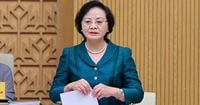Vietnam is on the verge of a sweeping transformation in its higher and vocational education sector, as the Ministry of Education and Training (MOET) announced a bold policy to restructure, merge, and reorganize universities and vocational institutions nationwide. The move, set to be implemented in 2026, is part of a larger strategy to modernize the country’s education system and better align it with the needs of society and the labor market, according to recent reports from Báo Nhân Dân and other major Vietnamese outlets.
At a regular government press conference held on October 5, 2025, Deputy Minister of Education and Training Lê Tấn Dũng laid out the details of the ambitious plan. The restructuring, he explained, is a major directive of the Vietnamese Communist Party, clearly affirmed in Resolution No. 71-NQ/TW of the Politburo, dated August 22, 2025. This resolution focuses on the breakthrough development of education and training, highlighting the need for urgent, decisive, and scientifically grounded reforms.
"This is a major policy of the Party, to be implemented seriously, urgently, and decisively," Deputy Minister Lê Tấn Dũng stated at the press conference, as reported by Báo Nhân Dân. He emphasized that the process must be both thorough and sensitive, given its significant impact on the emotions and mentality of many people. "The restructuring will have a great influence on many people’s feelings, so when implemented, it must be very careful, scientific, methodical, and resolute," he added.
The Ministry has been tasked with developing two specific projects: one focused on the rearrangement and reorganization of higher and vocational education institutions, and another on transferring some of these institutions to local authorities. Both projects will be submitted to the Prime Minister for approval, with implementation slated for 2026.
According to Báo Nhân Dân, the projects aim to clearly define the mission of each university and vocational institution, ensuring that restructuring is conducted with transparency and in accordance with established principles and criteria. This approach is designed to prevent negative phenomena such as favoritism, shortcuts, and corruption—issues that have sometimes plagued complex administrative reforms in the past.
Deputy Minister Lê Tấn Dũng was unequivocal about the Ministry’s commitment to transparency. "The Ministry of Education and Training will establish very specific and clear principles and criteria for implementation, ensuring openness and transparency, and avoiding favoritism, shortcuts, and negative phenomena during the process," he said. These principles will be based on Party and government resolutions, strategic development plans, and the approved national education network plan, as well as the country’s socio-economic development goals for the coming period.
One of the central goals of the restructuring is to more closely link training with practical societal needs and the demands of the labor market. As Vietnam’s economy continues to evolve, there is growing recognition of the need for graduates who are not only academically qualified but also equipped with practical skills that match the requirements of employers and the broader economy.
"Solving the training problem must be closely associated with practice and the requirements of society and the labor market," Deputy Minister Lê Tấn Dũng explained. He further noted that the new projects would be grounded in international experience and adapted to Vietnam’s unique circumstances, ensuring that each institution’s mission is clearly articulated and relevant to current and future challenges.
Crucially, the Ministry has acknowledged that it cannot undertake this massive task alone. Deputy Minister Lê Tấn Dũng stressed the importance of cooperation and consensus among central ministries, government sectors, local authorities, and—perhaps most importantly—the educational institutions themselves. "The Ministry of Education and Training recognizes its responsibility in this important matter, but it cannot act alone. There must be joint efforts, coordination, and consensus from central ministries, sectors, localities, and especially from universities and vocational education institutions," he said.
To foster this spirit of collaboration, the Ministry plans to solicit feedback from a wide range of stakeholders, including ministries, sectors, local governments, experts, and educational institutions. "We will seek opinions from ministries, sectors, localities, experts, and especially from universities and vocational education institutions, to build a high level of consensus during the development of the projects," Deputy Minister Lê Tấn Dũng affirmed. Once the projects receive approval from the relevant authorities, the Ministry has pledged to make all information public and provide comprehensive updates to media and press agencies.
Transparency, however, is not just a guiding principle for the restructuring itself—it is also central to the Ministry’s approach to public communication. In recent weeks, there has been a flurry of unofficial information and rumors circulating about the planned changes. The Ministry has responded by warning against the spread of misinformation and urging organizations and individuals not to share unverified details. "Recently, there has been some incorrect information circulating about this policy, which was not provided by the Ministry of Education and Training. Organizations and individuals are requested not to share information unless it has been verified and officially released," Deputy Minister Lê Tấn Dũng cautioned, as reported by Báo Nhân Dân.
The stakes are high. The planned restructuring is seen as a linchpin in Vietnam’s broader efforts to modernize its education system and ensure that it can meet the demands of a rapidly changing economy and society. By establishing clear, transparent criteria and seeking broad-based consensus, the Ministry hopes to avoid the pitfalls of previous reforms—most notably, the risk of favoritism, bureaucratic inertia, and public discontent.
International experience suggests that such large-scale educational reforms are rarely easy. They often require difficult decisions about mergers, closures, and reallocations of resources. Yet, as Deputy Minister Lê Tấn Dũng and the MOET leadership have made clear, the ultimate goal is to create a more dynamic, responsive, and equitable system—one that serves both the nation’s development goals and the aspirations of its people.
As the country prepares for these changes, all eyes will be on how the Ministry navigates the complex interplay of policy, public sentiment, and practical realities. The coming year will be a critical period for consultation, consensus-building, and careful planning. If successful, Vietnam’s education sector could emerge stronger, more focused, and better equipped to face the challenges of the 21st century.
With the Ministry’s commitment to openness and its insistence on clear, fair criteria, the process promises to be both rigorous and inclusive—a rare combination in the world of public administration. For educators, students, and families across Vietnam, the next steps will be watched with keen interest and, perhaps, cautious optimism.






